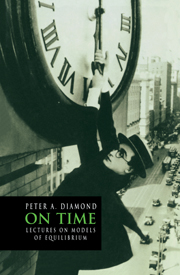1 - Short run and long run
Published online by Cambridge University Press: 31 December 2009
Summary
In the Preface to the first edition of his Principles of Economics, Alfred Marshall refers to the “element of Time” as “the centre of the chief difficulty of almost every economic problem” (1948, p. ii). I share Marshall's view of time as a source of difficulty. The picture of Harold Lloyd conveys my image of a theorist grappling with the modeling of time. In these lectures, I will examine how time is modeled in various economic analyses. My focus will be on the modeling of equilibrium, particularly equilibrium with many economic agents. I will present a leisurely tour through some economic analyses, with an eye on their treatment of time. The first lecture considers models of a single industry; the second, models of an entire economy. My hope is that economic analyses will improve from awareness of the link between how time is modeled and some of the conclusions reached by the models.
Short run and long run
In Book V of his Principles, Marshall considers equilibrium. Let me quote a summary paragraph:
[M]arkets vary with regard to the period of time which is allowed to the forces of demand and supply to bring themselves into equilibrium with one another, as well as with regard to the area over which they extend. And this element of Time requires more careful attention just now than does that of Space. For the nature of the equilibrium itself, and that of the causes by which it is determined, depend on the length of the period over which the market is taken to extend.[…]
- Type
- Chapter
- Information
- On TimeLectures on Models of Equilibrium, pp. 3 - 21Publisher: Cambridge University PressPrint publication year: 1994



